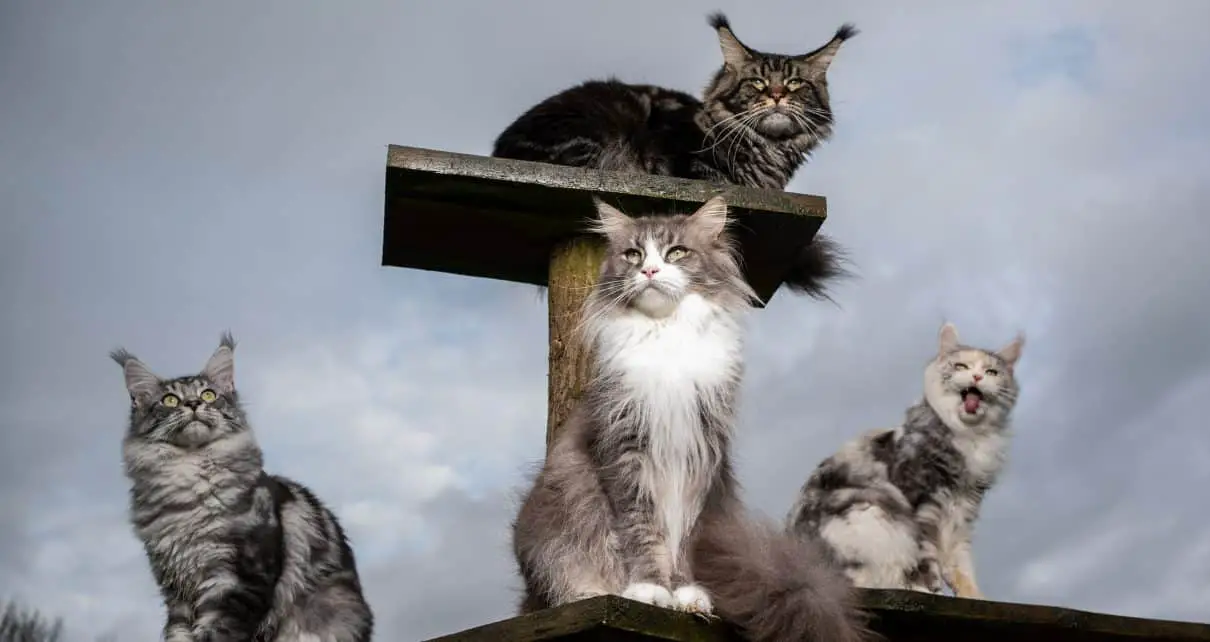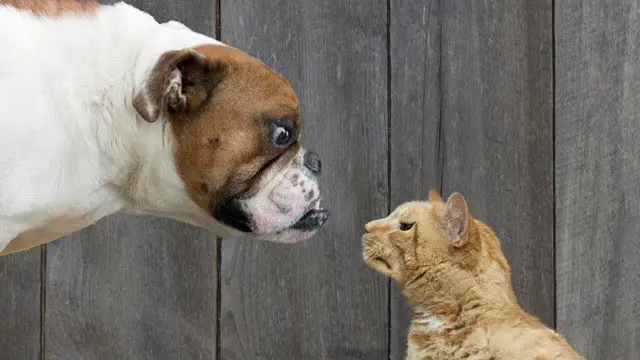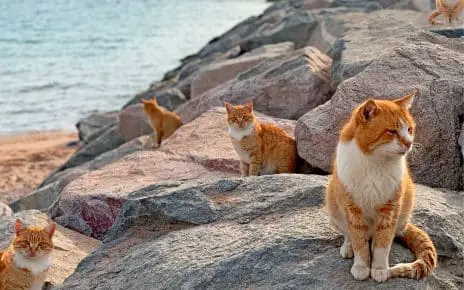An interesting set of random cats facts for cat enthusiasts.
Ailurophile
Do you adore all things feline? So, do we.
But why adopt the crazy cat lady label when we can call ourselves ailurophiles? This fancy schmancy term comes from the Greek ailouros for ‘cat’ and -phile for ‘love’ – translating to cat lover.
Oh, and that’s pronounced “eye-LOOR–uh-fyle.”
How do you use it in a sentence? Well, here’s a quote that also serves as an example sentence(s):
“It’s said in publishing that no cat book ever loses money. Maybe it’s true: bibliophiles tend to be ailurophiles, and both are tenacious breeds.” Toth, Emily, Meow mix, Women’s Review of Books, 1 Jul 1995.
Nose Prints and Fingerprints
Each cat has a nose pad with a unique ridged pattern that’s specific to that cat and that cat alone. Like human fingerprints. Just cuter.
Anyone who’s ever had a cat can testify to their amazing sleeping prowess. Cats can sleep as much as 16 hours every day and older cats dedicate even more of their day to sweet slumber – dozing away as much as 20 hours a day!
There’s no doubt about it – our feline friends have mastered the art of falling asleep anywhere, any time, on top of anyone. Which begs the question…why cats sleep so damn much
Hint: It’s not sheer laziness!
Cats and the Art of Sleeping
Anyone who’s ever had a cat can testify to their amazing sleeping prowess. Cats can sleep as much as 16 hours every day and older cats dedicate even more of their day to sweet slumber – dozing away as much as 20 hours a day!
There’s no doubt about it – our feline friends have mastered the art of falling asleep any where, any time, on top of anyone. Which begs the question…why do cats sleep so damn much
Hint: It’s not sheer laziness.
A Clean Cat is a Happy Cat
You go to pet your furry feline friend, walk off for a while, and come back to discover your beloved is methodically scrubbing off all your tender loving care.
What’s up with that?
Well, it’s nothing personal. Your cat’s seemingly OCD need to groom itself is just part of its nature. And as such, they’ve got all the tools they need built into them. Cats are naturally endowed with a barbed, rough-textured tongue with which to lick, forepaws that can be moistened with saliva and used as an all-natural washcloth, and teeth with which to dig out tougher debris.
And they develop this personal hygiene habit early on. Mama cats begin licking their kittens right after birth. It’s not only to clean them; the licking helps stimulate the release of urine and feces, rouses the kittens to suckle, and most significantly – provides comfort.
So, it’s not surprising that adult cats spend around a third – sometimes as much as half – of their waking hours – licking, grooming, and cleaning themselves. It not only keeps them pristine – it feels good fun. Fur real.
P.S. Next time your cat proceeds to vigorously clean its coat after a petting session, remember that your cat’s superior sense of smell allows it to read an immense amount of olfactory information about you, where your hands have been and even what mood you’re currently in. So far from taking offense, think of it as a sharing and bonding experience.
Cats Sweat Through Their Paws
Have you ever sniffed your cat’s paws? If you haven’t, we advise you not to do it on a hot day.
That’s cause cats sweat through their paws and when the weather is warm, they can wind up with four little sweaty paws that reek slightly of stinky socks.
While this may not be a fragrant bouquet for us, it’s surprisingly helpful for the cats. Cat’s paws also contain scent glands and that scent is mixed with the sweat from their paws and used to mark their territory.
And they do this all the time. While they’re walking – sometimes you’ll see them repeatedly treading on a spot. That’s not kitty Alzheimer’s, they’re just working their mark in. They do this even when they’re scratching and of course, when they’re kneading on their humans.
Yes, when your cat paw-kneads you like you’re a loaf of bread, it’s marking you as its very own human.
P.S. It’s not only their paws that cats use to mark their territory with – cats disperse their signature odor through various part of their body.
Each Cat Carries a Personal Perfume
Each cat carries his very own personal pheromone perfume. It might not smell like anything to humans since we only have somewhere between 5 to 20 million olfactory cells in our noses, but to cats – endowed with around 67 million olfactory cells – this scent is everything.
And they like to spread it around.
You already know that cats have scent glands in their paws, but they also have similar scent glands in the skin of the chin, lips, cheeks, forehead and even the tail. As each cat’s scent is unique to that cat and cat alone, this personal perfume serves as a useful way for a cat to mark something as his very own.
That’s why you’ll see your cat(s) rubbing all these parts of his body on anything and anyone he deems worthy enough to mark as his territory.
But this rubbing behavior – called bunting – isn’t just territorial, prime real estate hogging greediness. Studies show that your cat’s signature pheromone perfume also serves as a calming influence, helping your cat identify territories, objects, and humans as safe and familiar. These ‘home’ pheromones reassure your cat that he belongs in that environment, as well as conveys to other cats that the space has already been claimed.
So take it as a huge compliment next time Kitty head bumps you, does figure eights around your ankles or twined his tail around your leg. You’ve just been giving a dose of his powerful pheromone perfume!
The Cat’s Meow…is Mostly for You
Meow. What a term. So melodic. So multi-purpose. It’s a catch-all term that conveniently communicates a variety of feline thoughts from a simple “I want…” to the expression of more elaborate ultimatums like “Clean my litter box or I’ll sit on your face.”
But what’s most interesting is that a cat’s meow is usually reserved for her humans. Kittens meow to their mothers, but adult cats rarely meow at each other, instead choosing to hiss, purr, or spit when they must vocalize to another feline.
Or yowl, there’s that, too. This tends to happen when a cat wishes to find a mate – both females and males will yowl their hearts out, the former to advertise that their open to advances and the latter to indicate that they’re down for some loving’ as well.
But a cat’s meow. It’s mostly meant for her humans. Probably because it gets us to do their bidding.
As for communicating with other cats. Cats have more subtle ways of talking to their feline counterparts, like through the messages conveyed through their unique pheromonal scent, with their body language, or simply by touching their noses together in friendly greeting.
Cats are the Most Popular Pet
They’re independent yet affectionate. They’re even suitable for small spaces, naturally potty-trained and possess exceptional personal hygiene.
Is it any wonder why cats are the most popular pet in the world, outnumbering dogs by as many as three to one
Even in the US, a seemingly canine-obsessed country, cats are a more popular pet than dogs. The National Pet Owners Survey found people around the US owned 88 million cats as opposed to 75 million dogs.
But to be fair – cats technically aren’t the most popular pet, at least not in the US. Goldfish beat both cats and dogs – there are over 140 million of these forgetful fish being kept as pets in fish tanks around America.
Cats are the Only Mammals that Can’t Taste Sweetness
Turns out your cat is on a lifelong Atkins diet. Yup, sugar and spice and everything nice hold zero interest for a cat. Your feline friend is only interested in one thing: meat.
And that’s not just cause inside every sweet and furry kitty lurks a little killer, it’s also because cats cannot taste sweetness.
All cats – including the big cats – lack 247 base pairs of the amino acids that make up the Tas1r2 gene and as a result, can’t code for the proper protein, disabling their ability to taste sweets.
Pity the poor feline. Cats are alone among mammals in lacking the sweet gene.
And that’s not all – cats can’t only not enjoy sugars, but they may also lack the ability to digest them, such as glucokinase in their livers – a key enzyme that controls the metabolism of carbohydrates and prevents glucose from flooding the animal.
That’s why it’s good to shy away from buying cat food that contains corn or other grains – your cat is not used to the high concentration of carbohydrates in her diet and what Kitty can’t taste might be hurting her.
Our hearts go out to the felines who can’t taste the sugary delights the world has to offer but there is a silver lining: Kitty will keep her paws off your stash of cookies.
Cats Don’t Always Have 9 Lives
Turns out not all cats have 9 lives. It really depends where that feline calls home.
In various parts of Europe, cats are believed to have 7 lives. So contrary to popular belief, apparently not everyone is healthier in that part of the world.
And in Arabic countries – and Turkey – cats are said to have only 6 lives.
But whatever the number, the fact remains that most of the world has bought into the popular myth that cats have multiple lives to live.
This notion might come from various sources – an ancient proverb that claims “A cat has nine lives. For three, he plays. For three, he strays. And for the last three, he stays.” Or even William Shakespeare allusion to the multiple lives of cats in his famous play Romeo and Juliet.
Or maybe people noticed early on that the cat’s incredibly dexterity and ability to almost always land on their feet allowed them to survive situations that would’ve spelled the end for other, less agile animals.
Whatever the case, we’re pretty content to think our beloved felines will be back again for several more rounds of playing, straying and staying.
The Death Penalty for Killing a Cat
As a sacred, oft worshipped animal in Ancient Egypt, cats received many of the ancient culture’s highest respects.
In the event of fire, men guarded the scene to make sure no cats ran into and perished in the fire.
When a cat died, the entire household went into mourning as if for a human relative and would often go so far as to shave their eyebrows to express their loss.
Even the practice of mummification was extended to these sacred felines to guarantee they’d live as well in the afterlife as they’d lived on earth.
Given the social status felines held in ancient Egyptian culture, it comes as no surprise that the penalty for killing a cat was often death. And the general population’s strength of feeling toward cats was such that this applied even for accidental deaths.
The Greek historian Diodous Siculus writes of one such incident that occurred around 60 BC. He witnessed a Roman accidentally kill an Egyptian cat and despite pleas from pharaoh Ptolemy XII, an outraged mob quickly gathered and killed the Roman.
Cats are Only Partially Colorblind
Contrary to popular misconception, cats can see color.
Just not quite like we can – cats are partially color blind. Like us, they can see shades of blue and green, but reds and pinks are confusing as they can appear greener. Purple can also look like another shade of blue.
Say Hello with a Nose Rub
Cat’s meow mostly at their humans. So how do they communicate with their feline counterparts
Through a friendly nose rub, of course.
Just as we’d shake hands upon meeting another person, cats greet one another by rubbing their noses together. Whether these cats are meeting for the first time or longtime roommates catching up after a catnap, the greeting is the same – a gentle touch and sniff of each other’s noses.
Cats learn nose touching as kittens. They’re blind at birth, but they have fully developed touch receptors in their noses so nose touching is the first way they make contact with their mother. And this habit sticks throughout their adult lives.
But it’s more than mere habit – nose touching allows an even social exchange that puts both cats in an equally vulnerable position while at the same time relaying all sorts of useful information from cat to cat.
As you already know, cats have a high-developed sense of smell and a simple nose touch tells a cat where the other cat has been. And since each cat has unique scent that he marks his ‘home’ territory (and companions) with, a quick nose rub allows a cat to tell whether the other cat is in his “in group.”
How Cats Find Mates, the Easy Way
Human dating can be so complicated. There’s the filling out of online profiles, making eyes at strangers, or even seducing the friends of friends. And that’s all just to meet someone. Then you go through rounds of questions and answers in a conversational attempt to see if you mesh.
The whole courtship process takes ages, only to abruptly come to a close when either of you discovers a deal breaker in the other…which you might not even find out about ’til weeks, months of even years into a relationship.
Wouldn’t it be a lot easier if we could instantaneously gauge the viability of a potential partner by…sniffing their urine
As gross as it sounds, it works wonderfully well for our feline friends, who, on top of their already extraordinary olfactory senses, also possess a special scenting device known as the Jacobson’s – or vomeronasal – organ, which is used to analyze scent chemicals, mainly the pheromones in cat urine.
Cats use this handy little pheromone-deciphering organ to figure out the status of the animal that left the scent. And she can find out all sorts of useful information – the type of species, gender, health, reproductive status, etc.
All it takes is one good sniff of the scent.
Here’s how it works: When a cat comes across an intriguing smell, she’ll breathe the scent in through her mouth and then use her tongue to push the scent molecules up to the roof of her mouth to the Jacobson’s organ where she can ‘taste’ the scent.
You can tell when your cat is using her trusted mating device when her mouth is open, and her lips are curled in a funny sort of grimace – which is called the Flehman response.
It’s an awesome trick that allows a cat to continue breathing normally while simultaneously analyzing the finer points of a potential mate’s pheromonal states.
We have to admit we’re a little envious.
Cat Retrieval Armies Actually Existed
The export of cats was forbidden in ancient Egypt, partly because these cats were so useful to this agricultural society and partly due to the respect accorded to the cat in Egyptian society.
As semi-divine beings, cats could not be the property of anyone other than the pharaoh and exporting these sacred felines was highly illegal. So naturally, a thriving trade in smuggling cats across borders arose.
To prevent this prohibited smuggling, a branch of the government was formed solely to deal with this issue. And even more remarkably, court records confirm that armies were occasionally dispatched to rescue smuggled or kidnapped felines and bring them home to Egypt.
The Oldest Cat Ever Lived Longer than Jesus
According to the Guinness World Records, the oldest cat ever is Creme Puff who lived an amazing 38 years and 3 days.
Considering the average life expectancy of an indoor cat is only 9 to 15 years, that is more than impressive.We wonder what Creme Puff was eating…



